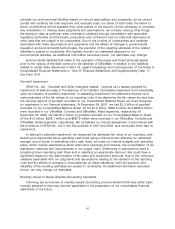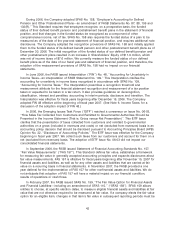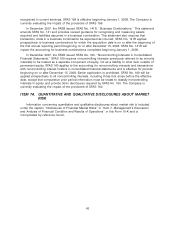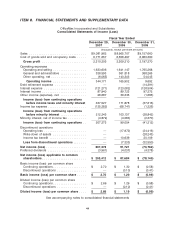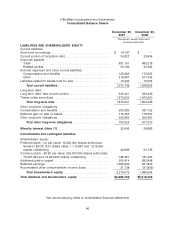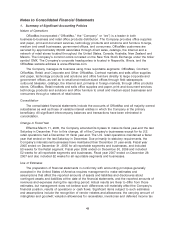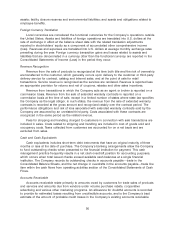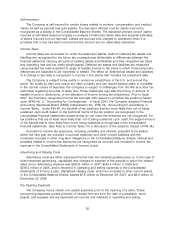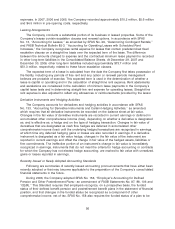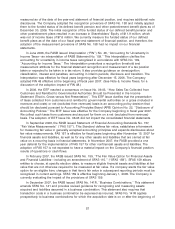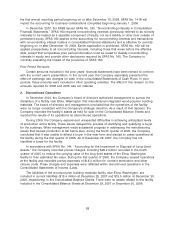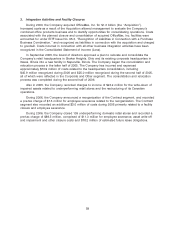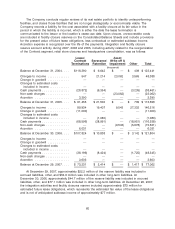OfficeMax 2007 Annual Report Download - page 55
Download and view the complete annual report
Please find page 55 of the 2007 OfficeMax annual report below. You can navigate through the pages in the report by either clicking on the pages listed below, or by using the keyword search tool below to find specific information within the annual report.Management believes that the Company’s exposure to credit risk associated with accounts
receivable is limited due to the size and diversity of its customer and vendor base, which extends
across many different industries and geographic regions.
The Company has an agreement with a third-party service provider that manages the
Company’s private label credit card program and directly extends credit to customers.
Prior to July 2007, the Company sold fractional ownership interests in a defined pool of
accounts receivable and retained a subordinated interest and servicing rights to those receivables.
The sale of the receivables under this program was accounted for under Statement of Financial
Accounting Standards (‘‘SFAS’’) No. 140, ‘‘Accounting for Transfers and Servicing of Financial
Assets and Extinguishments of Liabilities.’’ Sold accounts receivable were excluded from
receivables in the Company’s Consolidated Balance Sheet. The portion of the fractional ownership
in the transferred receivables that the Company retained is included in Receivables in the
Consolidated Balance Sheet. See Note 8, Sales of Accounts Receivable, for additional information
related to this terminated program.
At December 29, 2007 and December 30, 2006, the Company had allowances for doubtful
accounts of $14.5 million and $15.1 million, respectively.
Vendor Rebates and Allowances
The Company participates in various cooperative advertising and other marketing programs
with its vendors. The Company also participates in volume purchase rebate programs, some of
which provide for tiered rebates based on defined levels of purchase volume. These arrangements
enable the Company to receive reimbursement for costs incurred to promote the sale of vendor
products, or to earn rebates that reduce the cost of merchandise purchased. Vendor rebates and
allowances are accrued as earned. Rebates and allowances received as a result of attaining defined
purchase levels are accrued over the incentive period based on the terms of the vendor
arrangement and estimates of qualifying purchases during the rebate program period. These
estimates are reviewed on a quarterly basis and adjusted for changes in anticipated product sales
and expected purchase levels. Volume-based rebates and allowances earned are initially recorded
as a reduction in the cost of merchandise inventories and are included in operations (as a
reduction in cost of goods sold) in the period the related product is sold. Amounts received under
other promotional programs are generally event-based and are recognized at the time of the event
as a reduction of cost of goods sold or inventory, as appropriate, based on the nature of the
promotion and the terms of the vendor agreement. Advertising and other allowances that represent
reimbursements of specific, incremental and identifiable costs incurred to promote vendors’
products are recorded as a reduction of operating and selling expenses in the period the expense
is incurred.
Merchandise Inventories
Inventories consist of office products merchandise and are stated at the lower of weighted
average cost or net realizable value. The Company estimates the realizable value of inventory using
assumptions about future demand, market conditions and product obsolescence. If the estimated
realizable value is less than cost, the inventory value is reduced to its estimated realizable value.
Throughout the year, the Company performs physical inventory counts at all locations. For
periods subsequent to each location’s last physical inventory count, an allowance for estimated
shrinkage is provided based on historical shrink results and current business trends.
51


